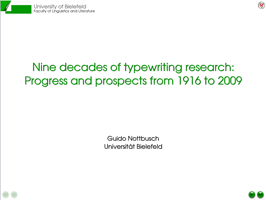| |
Nine decades of typewriting research:
Progress and prospects from 1916 to 2009
Guido Nottbusch
Presentation held at the 13th Biennial Conference EARLI in Amsterdam, August 25-29 2009.
 (92 kB) (92 kB)

(klicken öffnet Präsentation in neuem Fenster)
Abstract
The aim of this talk is to summarize the outcome of the research on the time course of typing starting in the twenties of the last century (e.g. Coover, 1923; Dvorak, Merrick, Dealey & Ford, 1936; Fendrick, 1937) until today. The factors influencing the interkey intervals will be classified by the amount of motor and/or language processes involved.
The early studies mentioned above exhibit very interesting results, including e.g. findings on different timing patterns in novice and skilled typists, the influence of standard and alternative keyboard layouts, and first hints towards linguistic effects such as word frequency. The emergence of video equipment and personal computers in the 1970s led to an increase of typing studies with an accuracy close to one millisecond. The focus of these studies was typing as a motor skill and the organization of its sub-processes. One question was the intra- and interpersonal variability of keystroke timing: the ratios between the interkey intervals for one word typed by one typist are relatively constant whereas typing speed may vary strongly. Comparing the interkey intervals for one word between several typists, typing skill and technique become important. Here, the motor patterns of novice and skilled typists differ strongly. Motor patterns were assumed to be independent of linguistic processes. Instead, readily specified lexical-orthographic information was supposed to be the input for the motor execution modules (e.g. Sternberg et al., 1978).
A number of factors influencing the time course of typing tested for in the studies conducted in the 1970s to 1990s can be summarized as (1) pure motor factors: keyboard layout, typing speed/skill, typing system (touch typing vs. 2-finger-system), typing sequence (1. same hand + same finger + same key 2. same hand + same finger + different key 3. same hand + different finger 4. different hand + same finger 5. different hand + different finger) or (interrelated) the digraph/trigraph/higher level n-graphs.
A second group of factors is influenced by language features (differing between languages) as well as motor premises and will be called the (2) interrelated factors. Digraph and trigraph frequency are good examples for this group. Though, these frequency effects can also be interpreted as motor factors. But even if trigraphs are controlled, word properties still have some effect on the interkey intervals – a fact that led Terzuolo & Viviani (1980) to postulate motor engrams for words, resulting in a debate with Gentner and collegues (e.g. Gentner, 1982) on the size of the base unit in typing. The latter proposed the view that sub-lexical units may be the cause of the effects.
A third group of factors can be called (3) pure linguistic factors. Word frequency or age of acquisition effects can be attributed to this class. But also smaller (lexical and sub-lexical) units can be of importance, i.e. morphemes and syllables. In order to test these effects, the effects of group (1) and (2) must be controlled. The effect of the syllable boundaries was analysed separately at first by Zesiger et al. (1994); morpheme effects were investigated in detail by Sahel et al. (2008).
The three factor classes described above were also subject to various error analyses that shall complete this review of typing studies and their outcome.
References
Coover, J. E. (1923). A method of teaching typewriting based upon a psychological analysis of expert typing. National Education Association, 61, 561–567.
Dvorak, A., Merrick, N. L., Dealey, W. L., & Ford, G. C. (1936). Typewriting behavior. New York: American Book Company.
Fendrick, P. (1937). Hierarchical skills in typewriting. Journal of Educational Psychology, 28, 609–620.
Gentner, D. R. (1982). Evidence against a central control model of timing in typing. Journal of Experimental Psychology: Human Perception and Performance, 8, 793–810.
Sahel, S., Nottbusch, G., & Grimm, A. (2008). The impact of frequency and semantic transparency on the time course of German compound production. Written Language and Literacy, 11(2), 221-228.
Sternberg, S., Monsell, S., Knoll, R. L., & Wright, C. E. (1978). Latency and duration of rapid movement sequences: Comparison of speech and typewriting. In G. E. Stelmach (Ed.), Information processing in motor control and learning (pp. 117–152). New York: Academic Press.
Terzuolo, C. A., & Viviani, P. (1980). Determinants and characteristics of motor patterns used for typing. Neuroscience, 5, 1085–1103.
Zesiger, P., Orliaguet, J.-P., Boë, L.-J., & Mounoud, P. (1994). The influence of syllabic structure in handwriting and typing production. In C. Faure; P. Keuss; G. Lorette, & A. Vinter (Eds.), Advances in handwriting and drawing: A Multidisciplinary Approach (pp. 389–401). Paris: Europia.

|
|





